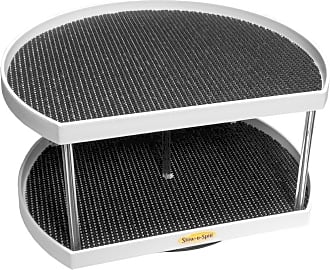The 10 Best Cabinet Turntables

This wiki has been updated 35 times since it was first published in April of 2016. Most of us are familiar with the frustration of fumbling through a cluttered cupboard or pantry without being able to find the item we are looking for. One of these handy lazy Susans, however, will save you from all that rummaging, as they fit in most cabinets and have turntables designed to keep jars, bottles, cartons, cans and other household supplies visible and easily accessible. When users buy our independently chosen editorial selections, we may earn commissions to help fund the Wiki.
Editor's Notes
July 27, 2020:
Upon review, the list required minimal maintenance, as we discovered no availability or quality issues with any of the existing items. We did note that the Oxo Good Grips is offered at a very reasonable price, given its sleek and efficient design. We also noticed that the mDesign Container is now available in more than four colors.
Cabinet turntables are typically offered in two distinct styles: single tier or two-tiered. The size of your cabinet space and the number of items you’re trying to organize will dictate which type is your best bet.
While most of the models on this list are of the freestanding variety, the Dowell Chrome will need to be installed, ideally within a base corner cabinet. Its kidney-shaped design provides space for a hinged door to open and close. It can be tricky for less-than-handy individuals to put together, but once it’s functional, its ample capacity will help you minimize clutter in an area where jumbled messes tend to materialize quickly.
July 17, 2019:
Eliminated the InterDesign Bin and MetroDecor Lazy Susan due to availability concerns. We added the mDesign Container to provide a similar option to the items we removed, though it does offer two tiers instead of one. We noted its rugged plastic design and strong stainless steel support rods, which lend this compact model durability and stability.
Also added the Dowell Chrome; unlike most of the turntables on this list, this model has to be installed within a corner cabinet. Some not-so-handy folks report that the assembly process can be a bit laborious, but few argue with the results. It’s kidney-shaped, with a 28-inch diameter and two tiers that can support 40 pounds each, making it suitable for storing a large amount of kitchenware.
In assessing the existing items, we noted that while the Madesmart Classic is a solid, economical option that’s available in multiple styles, it does come with labels on the side that are difficult to take off. These tend to leave a glue residue, which is also tough to remove.
Special Honors
Merillat Cabinetry Kit If your kitchen is stocked to the gills, why settle for a one or two-tiered model? This unit is built with three sturdy shelves specifically for placement within an angled corner cabinet. The platforms are 18 inches in diameter, and its height is adjustable so that it’ll fit into storage areas of different sizes. merillat.com
Janna Ugone Lazy Susans This line of lazy Susans offers a wide variety of colorful patterns to suit even some of the more eccentric home decor themes. Many have a nature motif, with images of wildlife and greenery, while others are more abstract in design. They’re available in 13-inch or 17-inch diameters. jannaugoneandco.com
Hardenbrook Hardwoods You’ll choose from three elegant wood types (walnut, cherry and sapele) when you design this custom turntable. You can arrange for names to be engraved on the back rim (in the font of your choosing) with a brief, personalized message. You can even include a logo, which is useful if it’s a business-related gift. hardenbrookhardwoods.com
A Game Changer In Kitchen Organization
You can install one in your fridge just as you would your cabinet, giving you a convenient way to organize all of your sauces and condiments.
Few people look forward to spring cleaning, and the inevitable part where you have to dig through the dark, cluttered caverns within your kitchen cabinets is particularly onerous. What you’ll discover is anyone’s guess: old, rotten food you’d completely forgotten about; some spice jars that would’ve come in handy dozens of times since last spring; even kitchen tools you’ve long since replaced.
Those of you with cabinet turntables, however, are far less likely to find yourselves in this unpleasant scenario. This is because those deep, hard-to-access recesses within your cabinet have been replaced with a rotating surface that makes all of the cabinet’s contents easy to see and retrieve.
Let’s break down how it works. Unlike a simple organizer, a cabinet turntable (otherwise known as a lazy Susan) usually features one or multiple rotating trays or carousels that spin around a center axis point. This allows you to use every square inch of your space — everything in the back of the cabinet is easily accessible via a quick spin.
While most people place these units in an otherwise difficult-to-access corner of the cabinet, this is by no means a mandatory practice. If your turntable consists of a simple, flat tray, you can place it on any flat surface in your cabinet, use it on your kitchen countertop, or even station it within a pantry.
Freestanding cabinet turntables are quite versatile, as you're able to move them to wherever they’ll be most useful. You can install one in your fridge just as you would your cabinet, giving you a convenient way to organize all of your sauces and condiments. It’s also a helpful addition to a dinner party, as a couple well-placed turntables will eliminate the need to pass the salt or butter multiple times throughout the evening.
Of course, we’re not telling you how to use your turntable or where you should store your spices, canned goods, and kitchen utensils — we’re merely making sure you’re aware of the increased accessibility that an easy-to-use lazy Susan brings to the table.
Assessing Your Kitchen — And Your Options
If you plan on installing the turntable within a cabinet or other enclosed space, you’ll need to measure the inside depth of that area before initiating the selection process. First, measure from the back wall to just inside the door frame, then measure the inside width of the cabinet from left to right. This will provide you with the turntable dimensions you’ll need; just make sure to purchase a model that leaves a couple of inches for clearance.
While most freestanding turntables are circular, plenty of other styles are available. For corner cabinets with L-shaped access points, kidney-shaped turntables are ideal, since they have a rounded, triangular cut-out that is designed to fit into 90-degree corners.
First, measure from the back wall to just inside the door frame, then measure the inside width of the cabinet from left to right.
D-shaped turntables come in handy for corner cabinets that cut across at a 45-degree angle. These are similar to the circular units, with one flat side that allows a cabinet door to close flush over the turntable. Half-moon models, shaped like half of a circle, are exclusively compatible with blind corner cabinets that feature only one door all the way to the right or left side of the cabinet.
Once you determine the style that fits your space, think about the build of the unit. Plastic models are the most common, as they’re economical, durable, and easy to clean. Because they often match the textured surface of the cabinets they’re used in, wooden turntables are popular, as well. Wire lazy Susans — which typically consist of heavy, welded metal — offer a sleek, modern look that accentuates the decor of a contemporary kitchen.
Some models include additional features, which may or may not be necessary for your needs. For example, if you’ll be placing it on a slick surface, a turntable with non-skid feet will be helpful. Some units have textured surfaces, which helps prevent items from sliding around. Others include integrated slide-out shelves for even easier access to the contents within.
You should also take into account the height of the lip or side walls, as this can vary significantly between models. If you plan on storing tall items that can easily tip over, you’ll want a sturdy lip or walls with a bit of height to them. You don’t necessarily need to worry about the walls obstructing your vision, as many units are designed with clear walls to provide a full view of the turntable’s contents.
The Cabinet Turntable And Its Lazy Susan Roots
I know what you’re going to ask, so I’ll cut right to the chase: no, we do not know the actual identity of the “Susan” referenced in this tool’s quirky name.
While the origins of its use are not totally clear, the Boston Journal first referenced the term lazy Susan in an article from one of its 1903 issues. However, the type of product that article referred to dates back to the 18th century.
While the origins of its use are not totally clear, the Boston Journal first referenced the term lazy Susan in an article from one of its 1903 issues.
Etymologists link the phrase to a variety of devices that fell under the term dumb waiter, which appears to have originated in Britain during the early 1700s. These were essentially wheeled serving trays that replaced food servants in some cases. Eventually, people started applying the term to rotating serving trays, as well.
Thomas Jefferson brought the idea to the United States, and by the mid-1800s, Americans were using the term to describe these devices that made it easier to serve a table without a servant. As time went on, its design evolved to the point where it was acting as a self-serving rotating dinner table, inching it closer to the modern version of the lazy Susan.
It was not until the 1950s that it finally went mainstream, when San Francisco restauranteur George Hall made the rotating tray an integral part of his Chinese restaurants. It caught on, and its popularity began to span the globe. During this time, cabinet versions of the turntable began to appear, though table lazy Susans remain popular to this day, as well.















